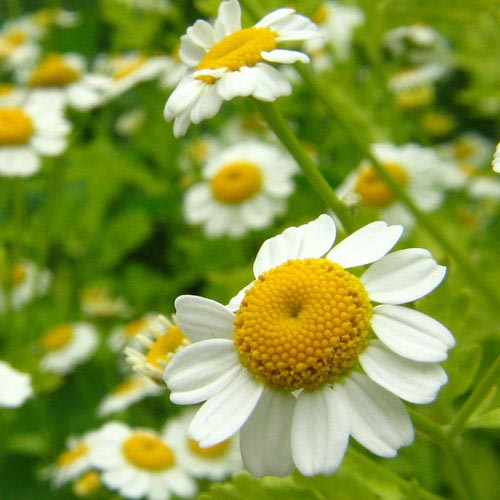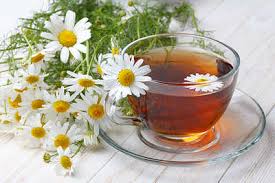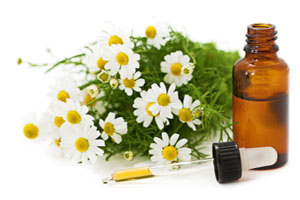 Loading... Please wait...
Loading... Please wait...A Tiny Flower’s Secret.
Posted by Patricia "Maus" Delgado on 21st Jul 2016
Chamomile is an herb that originates from a blooming plant in the daisy family. Both new and dried blossoms can be used and can work on a variety of well-being issues. The key oil in chamomile that makes a difference is known as bisabolol, which has many calming and microbial properties. The flower resembles a daisy with white petal and yellow circle florets.
.
Chamomile has been used as a medicine for thousands of years, dating back to the ancient Egyptians, Romans, and Greeks. Discover the health benefits of chamomile and how to use this wonderful infusion to your advantage.

You probably heard of Chamomile as an herbal tea. Many think Chamomile is for anxiety and insomnia, but it’s far more than a soothing nervine. From tea and tinctures to soap and salves, chamomile’s many uses and aroma have long-been welcomed into our lives. Due to its chemical composition which consists of amino-acids, antioxidants, flavonoids, volatile oils and vitamin B complex, chamomile infusions help rejuvenate the texture of your hair and skin. Whether used internally or externally, you can use chamomile to treat a multitude of complaints and illnesses.
As a tea, Chamomile is anti-inflammatory and anti-bacterial and can be used to treat the common cold and sore throats. When have the flu I brew a pot full, fill my pitcher to the rim and have it on my desk or next to my bed to sip on regularly. I find that if you keep your throat well moistened then bacteria can’t survive and the throat ache will soon go away. If you like your tea sweeter then you can always add a little honey to your cup of tea.

For severe head colds such as frontal sinusitis, a blocked nose or angina you can take a steam bath using Chamomile. In the evening before you go to bed you can help your cold with a steam bath. Take a handful of dried chamomile flowers, put them in a bowl and pour over with hot water. Hold your head over the bowl and lay a damp cloth over your head and shoulders and breathe in the steam deeply for five to ten minutes.
If you happen to suffer from acne or just the occasional blemish, you can treat yourself to a steam baths every evening for a few days. Remember to remove your make-up first! The warm steam will open your pores allowing anti-inflammatory chamomile to soothe your blemished skin.

If you want to make your own healing tincture from concentrated here’s a simple chamomile tincture recipe. You can use this externally on itchy mosquito bites, diluted in a bath, or treat eczema or other skin disorders. You can even add a few drops to your favorite face cream.
You can also use this Chamomile tincture internally. The diluted tincture can be used to treat inflammations in the mouth or to gargle if you have a cold. Even toothache can be relieved if you regularly rinse with a glass of warm water with a few drops of chamomile extract. And all that is almost free and using a natural, home-made remedy. Amazing isn’t it? If you don’t want to wait for your tincture to cure, you can always purchase Maus’ Chamomile Tincture here.
Recipe:
- Half fill a glass jar with a screw top with dried or fresh chamomile.
- Pour your choice of alcohol (vodka, schnapps or brandy) over the chamomile until they are well covered and close the jar.
- Leave the tincture to mature in a cool place for four to six weeks shaking the jar every other day or so.
- Now you have to filter: place a coffee filter over a second jar and pour the tincture through the coffee filter. It will drip slowly into the jar.
- Fill the tincture into a dark bottle and close well.
- Make sure you label your bottle with the content and date. Store your tincture in a cool place and it will last for 5-7 years.
- You can take 6-12 drops of this tincture internally two-three times daily.
And if all these positive effects aren’t enough, here are more ways to use: Use it to help with detoxing! Chamomile has diuretic properties so it helps cleanse the blood and rid the body of impurities. Chamomile can even ease rheumatic illnesses and gout.
Chamomile tea soothes stomach aches in children and adults alike. It is also very helpful for gastrointestinal complaints. If you have a sensitive stomach, sipping on a cup of chamomile tea will soon ease the discomfort. Chamomile also helps with diarrhea, constipation and flatulence. It eases pain, is anti-bacterial and relaxing.
Using chamomile in a sitz bath once or twice a week can help with weak periods, vaginal inflammation (thrush), menstrual cramps and abdominal inflammation. You can use the tincture described above diluted in water.
How can one herb have so many positive properties! That is why it isn’t surprising that Maus uses chamomile in her herbal teas, tinctures and massage oils and they are relaxing and soothing.
You can also find Maus’ favorite recipes using Chamomile flowers here.
 This is about it for this blog, I'll squeak at you next week with a new entry.
This is about it for this blog, I'll squeak at you next week with a new entry.
